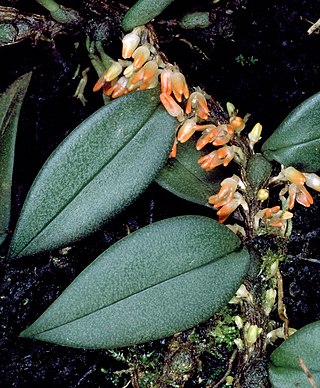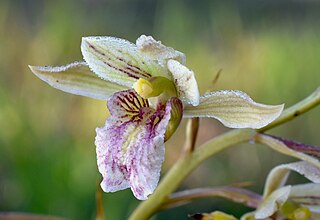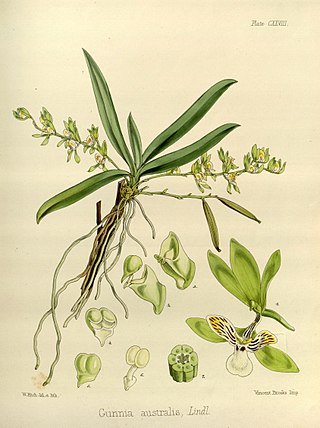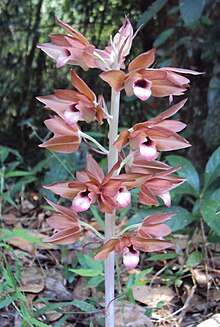
Acriopsis emarginata, commonly known as the pale chandelier orchid, is a species of orchid endemic to Queensland. It is a clump-forming epiphyte with dark green leaves and curved, branching flower stems with many white and cream-coloured flowers.

Dendrobium jonesii, commonly known as the oak orchid is a species of epiphytic or lithophytic orchid endemic to far north Queensland. It has spindle-shaped pseudobulbs, up to seven thin, dark green leaves and up to thirty five crowded, star-like, fragrant cream-coloured or white flowers with purple markings on the labellum.

Bulbophyllum schillerianum, commonly known as the red rope orchid, is a species of epiphytic or lithophytic orchid. It has well-spaced pseudobulbs each with a single grooved leaf and cluster of small, red or orange flowers with a hairy labellum. It grows on trees and rocks sometimes in rainforest but also on trees in cleared paddocks, and is endemic to eastern Australia.

Dendrobium trilamellatum, commonly known as the fragrant tea tree orchid or large tea tree orchid, is a species of epiphytic orchid found in northern Australia and New Guinea. It has spindle-shaped pseudobulbs, between three and seven leathery, dark green leaves and between three and fifteen yellow, yellowish brown or brown flowers with a mauve to purple labellum.

Aphyllorchis queenslandica, commonly known as the yellow pauper orchid, is a leafless terrestrial mycotrophic orchid in the family Orchidaceae. It has up to twelve dull yellow flowers on a thin, fleshy, purple flowering stem and is endemic to tropical north Queensland where it grows in rainforest.

Eulophia venosa, commonly known as the pointed corduroy orchid, is a plant in the orchid family and is native to India, parts of Southeast Asia as well as New Guinea and northern Australia. It is a deciduous, terrestrial orchid with one large and one small leaf and between six and twenty pale green or yellowish flowers with purple markings. It grows in rainforest and grassy forests.

Eulophia bicallosa, commonly known as the green corduroy orchid, is a plant in the orchid family and is native to areas from tropical Asia to northern Australia. It is a terrestrial orchid with a single narrow leaf and between 10 and 20 pale green or cream-coloured flowers with purplish markings. It grows in rainforest and woodland.
Tainia trinervis, commonly known as the ribbon orchid, is an evergreen, terrestrial plant with crowded pseudobulbs, each with a single smooth, shiny leaf and up to fourteen greenish to yellowish flowers with red or purplish stripes in the middle. It is found in tropical Southeast Asia, New Guinea and northern Australia.
Aphyllorchis anomala, commonly known as the simple pauper orchid, is a leafless terrestrial mycotrophic orchid in the family Orchidaceae. It has up to twenty white flowers with purple markings on a deep purple flowering stem and grows in shady rainforest in tropical north Queensland.

Epipogium roseum, commonly known as ghost orchid, leafless nodding orchid or 虎舌兰 , is a leafless terrestrial mycotrophic orchid in the family Orchidaceae. It has up to sixteen cream-coloured, yellowish or pinkish flowers with an enlarged ovary on a fleshy hollow flowering stem. This ghost orchid is widely distributed in tropical Africa, Asia, Southeast Asia, New Guinea, Australia and some Pacific Islands.

Dendrobium adae, commonly known as the slender cane orchid, is an epiphytic, sometimes lithophytic orchid in the family Orchidaceae. It has cylindrical pseudobulbs, up to four dark green leaves and up to six white or greenish to apricot-coloured flowers. It grows in tropical North Queensland, Australia.
Dendrobium biconvexum, commonly known as the Mount Windsor rock orchid, is a species of lithophytic orchid that is endemic to tropical North Queensland, Australia. It has spindle-shaped pseudobulbs, between two and four thick, leathery leaves and up to seventy five white or cream-coloured flowers with purple markings on the labellum.
Dendrobium neospectabile, commonly known as the Eungella king orchid, is a species of epiphytic or lithophytic orchid that is endemic to tropical North Queensland. It has cylindrical, yellowish green pseudobulbs, up to three thick, leathery leaves and up to two hundred and fifty crowded cream-coloured to pale yellow flowers with reddish purple streaks on the labellum.

Bulbophyllum maxillare, commonly known as the red horntail orchid, is a species of epiphytic orchid with tapered grooved, dark green to yellowish pseudobulbs, each with a single large, thin leaf and a single reddish flower with yellow or white edges. The lateral sepals are much larger than the dorsal sepal which in turn is much larger than the petals. It grows on the lower branches of rainforest trees in India, New Guinea and tropical North Queensland.

Micropera fasciculata, commonly known as the pale dismal orchid, is a species of epiphytic or lithophytic orchid with wiry stems forming large, tangled clumps. It has stiff, leathery leaves and flowering stems with between ten and twenty cream-coloured flowers with a white labellum. This orchid occurs in New Guinea, Queensland, the Solomon Islands and New Caledonia.

Pomatocalpa macphersonii, commonly known as the blotched bladder orchid, is an epiphytic or lithophytic orchid with thick, cord-like roots, between two and eight dark green, leathery leaves and up to thirty cup-shaped, yellow flowers with red blotches and a white labellum with red blotches. It usually grows on rainforest trees and is found in New Guinea and tropical North Queensland, Australia.

Robiquetia gracilistipes, commonly known as the large pouched orchid, is an epiphytic or lithophytic orchid from the family Orchidaceae that forms large, hanging, straggly clumps. It has long, thick, roots, a single stem, many thick, leathery leaves and up to forty cream-coloured, pale green or brownish flowers with red spots and a three-lobed labellum. It grows on trees and rocks in rainforest, usually in bright light. It is found in Malesia including New Guinea, the Solomon Islands and tropical North Queensland, Australia.
Sarcochilus argochilus, commonly known as the northern lawyer orchid, is a small epiphytic orchid endemic to Queensland. It has up to eight thin leaves and up to twelve small bright green to yellowish green flowers with a white labellum.

Sarcochilus australis, commonly known as the butterfly orchid or Gunn's tree orchid, is a small epiphytic orchid endemic to eastern Australia. It has up to ten oblong, dark green leaves and up to fourteen small green to yellowish or brownish flowers with a mostly white labellum.

Sarcochilus serrulatus, commonly known as the banded butterfly orchid, is an epiphytic orchid endemic to tropical North Queensland. It has up to six crowded leaves with finely toothed and wavy edges and up to ten reddish brown flowers with a white, yellow-banded labellum.















